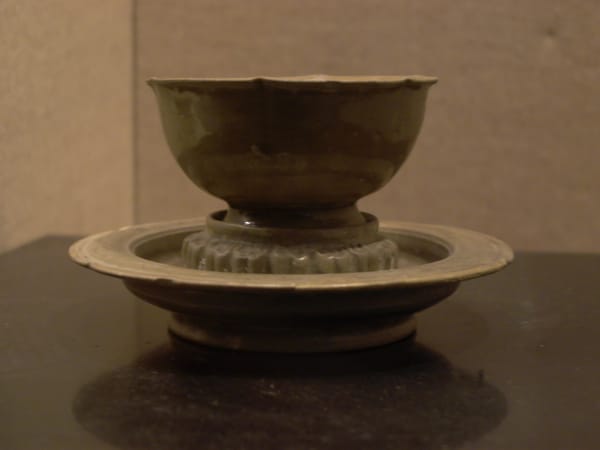Have you ever wondered if the seemingly ordinary teacup in your hand carries the codes of millennia-old culture?
Each time I slow down, holding an antique tea bowl and taking a gentle sip, I can't help but imagine: what kind of history has this cup lived through? Was it once resting in a scholar’s study, surrounded by poetry, ink, and brush? Or perhaps it witnessed dynastic changes from the halls of an aristocrat’s residence?
In this article, we step into the world of teacups and decode the hidden historical messages embedded within, using the lens of semiotics. Even if you know nothing about tea culture, don’t worry—we’ll savor this cultural journey slowly, together.
Teacup Semiotics: Unlocking the Silent Language of Ceramics
So, what is semiotics? Think of it as a key to unlocking the cultural codes hidden behind everyday objects. In the realm of teaware, every detail—material, shape, glaze, and ornament—serves as a symbol reflecting the aesthetics and lifestyle of a particular era.
Semiotics breaks down the teacup into two parts: the “signifier” and the “signified.”
The “signifier” refers to the visible aspects—its shape, size, pattern, and design. The “signified” relates to the material substance—such as the clay body or the glaze. Together, they form a system of signs that allow us to interpret the origins and worth of a teacup.
A Timeless Journey: From Prehistoric Tools to Purposeful Teaware
The story of the teacup begins in ancient times.
Archaeological findings from Neolithic sites like the Yangshao, Dawenkou, and Longshan cultures reveal early forms of drinking vessels. Though not yet made for tea, these cups were used for everyday food and drink.
As time progressed, teacups began to take on their own identity. In the Six Dynasties period (229–589 CE), the appearance of celadon cup-and-stand sets marked the emergence of tea appreciation. These early tea vessels were characterized by elegant glazes and simple forms—just as Tang Dynasty tea sage Lu Yu praised the “Yue ware tea bowls” as “the finest in the world.”
The Tang Dynasty was a golden age of tea culture and a turning point in the evolution of the teacup. It was during this period that tea cups were formally separated from other tableware, becoming dedicated tools for tea drinking. “A cup is a vessel for drinking,” but from then on, tea parted from wine—ushering in an era of specialized teaware.
Decoding Authenticity: The Semiotic Keys to Teacup Identification
How do we use semiotics to identify the authenticity of teacups? The process requires a multi-faceted analysis.
Chronological Signs: Traces of Time
Each era has its own distinctive teacup styles. For example, Six Dynasties celadon cup-and-stand sets were known for their refined simplicity. Tang teacups were more varied, including colored-glaze and marbled clay vessels. Song Dynasty Jian ware teacups, with their iconic “hare’s fur” glaze, became key tools in tea competitions.
When examining a cup labeled as “Song Dynasty Jian ware,” your first step is to assess its shape, glaze, and texture. If it appears more like a Ming or Qing-style piece, it's likely a later imitation.
Material Symbols: Touching the Texture of History
The material of a teacup plays a crucial role in authentication. Early teacups were mainly ceramic, though examples made from glass, metal, or lacquerware also exist.
Take celadon for instance: Yue ware celadon is celebrated for its “ice-like jade” clarity, with a fine body and translucent glaze. In contrast, Ou ware celadon is more rugged but equally expressive. If a teacup claims to be Yue ware but has coarse clay and uneven glazing, its authenticity should be questioned.
In 1985, the underground palace of Famen Temple in Shaanxi yielded glass tea bowls and saucers—evidence of cross-cultural exchange and a testament to the diversity of Tang Dynasty teaware.
Form Symbols: A Harmony of Shape and Function
The shape of a teacup isn’t just aesthetic—it reflects functional needs. The invention of the cup-and-stand is attributed to the daughter of Tang Dynasty official Cui Ning, who devised a saucer to prevent burnt fingers. She even added a wax ring to stabilize the cup—giving rise to the earliest cup stands.
When authenticating a cup, its form must align with its intended use and historical period. For example, Song Dynasty teacups, designed for tea competitions, often had wide mouths and shallow bowls to better showcase the floating patterns of tea froth.
Decorative Symbols: Where Beauty Meets Meaning
Ornamentation on teacups often reflects deep cultural values. For instance, the expressive lotus motifs on Southern Dynasties celadon bowls represent not only beauty, but also a philosophy of elegant living. The famous “hare’s fur” glaze on Song Jian ware is a union of craft and nature.
When you encounter a teacup with exquisite decorations, consider whether the motifs, techniques, and symbolism align with the period it claims to belong to. A cup advertised as Song ware but featuring clear Ming or Qing elements is likely a reproduction.
Case Studies in Counterfeit Detection
The collectible market for antique teacups is riddled with imitations. Here are some common fraud cases and how to spot them:
The Ming Dynasty Chicken Cup: A Masterclass in Deception
The “chicken cup” from Jingdezhen kilns is one of the most prized types of Ming Dynasty teacups. Due to its rarity, fakes abound. While replicas may closely mimic the original in body, glaze, and painting, subtle clues reveal the truth. Genuine examples feature finer porcelain, naturally aged glazes, and a painterly quality that's hard to forge—along with a unique patina formed over centuries.
Song Dynasty Jian Ware with “Imperial Use” Marks: A Misleading Mashup
Some counterfeiters enhance Jian ware bowls by carving “imperial use” inscriptions on their bases, falsely labeling them as official ware. However, archaeological evidence confirms that authentic Song Dynasty Jian ware lacked such marks. These are often later additions—or composite pieces made from unrelated fragments.
Becoming a Teacup Connoisseur
To master the art of teacup identification through semiotics, you’ll need to hone the following skills:
Look More, Touch More, Compare More
Hands-on experience is key. Visit museums and exhibitions often. Examine authentic pieces closely and build a tactile familiarity with different kiln styles and dynasties.
Learn the Cultural and Historical Context
Understanding the history behind a teacup deepens your ability to discern its origin. For example, knowing the value of Yue ware during the Tang Dynasty helps you appreciate why its clarity and elegance were so revered.
Observe Details and Build a Systematic Framework
Effective authentication depends on consistent criteria: body, glaze, ornamentation, form, and inscriptions. For instance, distinguishing between a genuine “Chenghua” blue-and-white cup from the Ming era, a Qing Dynasty replica, or a modern reproduction requires a well-structured evaluation system.
Final Thoughts: The Beauty of Teacups Lies in Interpretation
Each teacup is a cultural symbol carrying layers of historical and aesthetic meaning. Through the lens of semiotics, we can decode these meanings, uncover authenticity, and better appreciate the depth of Chinese tea culture.
Just like tea tasting, identifying antique teaware is an art of slowness. It invites us to pause, observe, and reflect—only then do its subtle nuances reveal themselves.
Next time you hold a teacup, take a closer look at its shape, feel its texture, and imagine its story. That humble vessel may well be a key to ancient civilization—allowing us to converse with history, steep in heritage, and taste the timeless charm of tea culture.
The beauty of a teacup begins with its form, is refined by its material, and elevated through its meaning. May we all, in the quiet act of tea drinking, cherish this centuries-spanning cultural inheritance.


